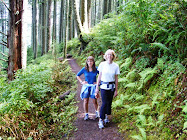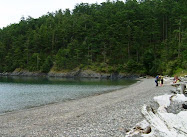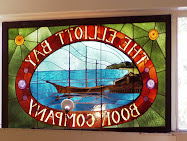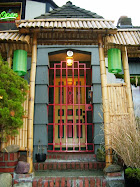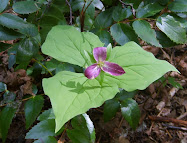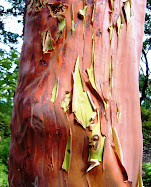A few weeks ago I meet up with some former high school classmates (thank you FaceBook) on a cloudy June morning for a hike at Larch Mountain. We grew up in East Multnomah County just east of Portland, Oregon, so like homing pigeons we rendezvous in Fairview/Wood Village for the 30+-minute drive up the Sandy River and beyond on the Historic Columbia River Scenic Byway. (Just reopened on June 24, 2014, after a major rockslide.)
 |
| Yikes! Highway has since reopened. |
Although I developed an adolescent passion for Cascade volcanoes and could rattle off all their names and elevations (Mt. Hood/Wy'East, elevation 11,245 feet; Mt. Rainier/Tahoma, elevation 14,410 feet....), I didn't know or remember that Larch Mountain is an extinct shield volcano until I researched hiking there for today's outing.
With a fairly early start, we arrive at the end of the road at Larch Mountain around 8ish, where only one other car is parked so far on a Saturday morn. The Larch Mt. trailhead with a big sign is easy to find on the left side of the lot, and we head down the well-maintained trail (#441) into the misty forest.
Essentially the trail descends into the old crater and loops back up, with an elevation gain and loss of about 1,300 feet. However, it just seems like a walk through a forest and we can't particularly tell we're in an ancient caldera.
As we descend, we're engulfed in increasingly thick green underbrush, with sweet early summer wildflowers alongside the trail.
 |
| Bunchberry dogwood |
 |
| Wild rhododendron |
Not far beyond the junction we come to an old log bridge over a boggy creek and stop to swig some water and enjoy the lush, profusely green forest around us. At the junction just past the bridge, we stay right on Trail #444.
A little ways on we pass the one open area of the whole hike, an almost-filled in lake which apparently is deep in the old crater. Then we meander along the trail with a few ups and downs through what feels like an enchanted forest. I tell Colleen I truly feel nourished by walking through a healthy forest like this, and she enthusiastically agrees.
 |
| Nurse log |
On the last stretch up through the forest, we pass huge old stumps along the trail with vine maples and other shrubs sprouting out of the tops, like so many mega-sized green bouquets. Most of the mountain was logged off in the early 20th century, although old growth remains in parts of the crater.
And suddenly the trail dumps us onto the road, where we walk up the last 3/10 mile to the car. Even though it's socked in up here today, we still dash up and down the paved trail to the small summit lookout at Sherrard Point, an old basalt lava plug.
 |
| Views not so much today |
 |
| Looking down from viewpoint |
By the time we leave, the parking lot has started to fill up, despite the clouds and lack of views. Of course, any Northwesterner knows, often the best time to be outdoors is NOT on the bluebird days (which we do love too).
Maybe next time we do a car shuttle and hike down to Multnomah Falls. But on a day enshrouded in clouds and mist, a hike through the emerald green forest up here at Larch Mountain with old friends/now new friends was just perfect.
Have you hiked this trail or down to Multnomah Falls from Larch Mountain? Would love to hear about your trip or other favorite hikes in Comments below. Happy trails and thanks for visiting Pacific Northwest Seasons.
When You Go
For particulars, a map, and directions to Larch Mountain, click here. Larch Mountain and the trail system is within the Columbia Gorge National Scenic Area, and a Northwest Forest Pass or $5 fee is required to park. The road to Larch Mountain is only open during the summer and fall and generally closes by November. This year the road opened in late May.


























































